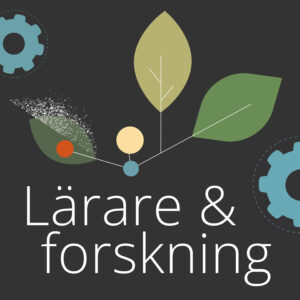Att skapa en känsla för evolution – högstadieelevers epistemiska känslor och meningsskapande om naturligt urval
DOI:
https://doi.org/10.61998/forskul.v13i2.24322Nyckelord:
epistemiska känslor, evolution, formativ intervention, förundran, grundskolaAbstract
Denna artikel bygger på resultat från ett samverkansprojekt där en högstadielärare och forskare gemensamt genomförde formativa interventioner för att undersöka epistemiska känslor – särskilt förundran – som pedagogiskt verktyg i undervisning om evolutionära processer. Förundran beskrivs ofta som en känsla med stor potential att stärka elevers engagemang och förståelse av naturvetenskap. Trots detta finns det få empiriska studier som har undersökt fenomenet i autentiska klassrumssammanhang. I denna studie analyserades ljud- och videoinspelningar av en lektion som utformats för att främja upplevelser av förundran. Genom kvalitativ innehållsanalys i kombination med multimodal interaktionsanalys identifierades hur elever skapade mening om, och uttryckte känslor i relation till undervisningens innehåll. Resultaten visar att eleverna resonerade mer djupgående kring begreppen konkurrens, variation och anpassning – processer som de även visat känslomässigt engagemang inför. Studien belyser den pedagogiska potentialen i att skapa utrymme för epistemiska känslor i undervisning om komplexa naturvetenskapliga processer.
To create a sense of evolution – lower secondary school students' epistemic emotions and meaning-making about natural selection
This study is based on a collaborative project in which a lower secondary science teacher and researchers carried out formative interventions to explore epistemic emotions—particularly wonder—as a pedagogical tool in teaching evolutionary processes. Wonder is frequently highlighted as an emotion with strong potential to enhance students’ engagement in and understanding of science. However, few empirical studies have examined this phenomenon in authentic classroom settings. By using qualitative content analysis combined with multimodal interaction analysis of an audio- and video-recorded lesson designed for wonder, the study identified how students made meaning of and expressed emotions in relation to the subject matter. The results show that students engaged in more in-depth reasoning around the concepts of competition, variation, and adaptation—processes that also evoked emotional engagement. The study highlights the pedagogical potential of intentionally creating space for epistemic emotions in the teaching of complex scientific processes.
Referenser
Anderson, C. L., Dixson, D. D., Monroy, M. & Keltner, D. (2020). Are awe‐prone people more curious? The relationship between dispositional awe, curiosity, and academic outcomes. Journal of Personality, 88(4), 762–779. https://doi.org/10.1111/jopy.12524 DOI: https://doi.org/10.1111/jopy.12524
Bezemer, J. J. & Kress, G. R. (2015). Multimodality, learning and communication: a social semiotic frame (1 uppl.). Routledge. https://doi.org/10.4324/9781315687537 DOI: https://doi.org/10.4324/9781315687537
Bjerknes, A. L., Wilhelmsen, T. & Foyn-Bruun, E. (2024). A systematic review of curiosity and wonder in natural science and early childhood education research. Journal of Research in Childhood Education, 38(1), 50–65. https://doi.org/10.1080/02568543.2023.2192249 DOI: https://doi.org/10.1080/02568543.2023.2192249
Bonnette, R. N., Crowley, K. & Schunn, C. D. (2019). Falling in love and staying in love with science: ongoing informal science experiences support fascination for all children. International Journal of Science Education, 41(12), 1626–1643. https://doi.org/10.1080/09500693.2019.1623431 DOI: https://doi.org/10.1080/09500693.2019.1623431
Brady, M. (2009). Curiosity and the value of truth. I A. Haddock, A. Millar & D. Pritchard (Red.), Epistemic value (s. 265–283). Oxford University Press. https://doi.org/10.1093/acprof:oso/9780199231188.003.0013 DOI: https://doi.org/10.1093/acprof:oso/9780199231188.003.0013
Caiman, C. & Jakobson, B. (2022). Aesthetic experience and imagination in early elementary school science – a growth of ‘Science–Art–Language–Game’. International Journal of Science Education, 44(5), 833–853. https://doi.org/10.1080/09500693.2021.1976435 DOI: https://doi.org/10.1080/09500693.2021.1976435
Campbell, N. A., Urry, L. A., Wasserman, S. A., Minorsky, P. V., Cain, M. L. & Orr, R. B. (2020). Biology a global approach. Pearson Education Limited.
Candiotto, L. (2019). Epistemic emotions: The case of wonder. Revista de Filosofia Aurora, 31(54). https://doi.org/10.7213/1980-5934.31.054.DS11 DOI: https://doi.org/10.7213/1980-5934.31.054.DS11
Cuzzolino, M. P. (2021). “The awe is in the process”: The nature and impact of professional scientists “experiences of awe”. Science Education, 105(4), 681–706. https://doi.org/10.1002/sce.21625 DOI: https://doi.org/10.1002/sce.21625
Dawkins, R. (2000). Unweaving the rainbow: Science, delusion and the appetite for wonder. HMH.
Dewey, J. (1910). Science as subject–Matter and as method. Science, 31(787), 121–127. https://doi.org/10.1126/science.31.787.121 DOI: https://doi.org/10.1126/science.31.787.121
Einstein, A., Seelig, C., Bargmann, S., Unna, I. & Wolff, B. (1954). Ideas and opinions.
Crown Publishers.
Gail Jones, M., Nieuwsma, J., Rende, K., Carrier, S., Refvem, E., Delgado, C., Grifenhagen, J. & Huff, P. (2022). Leveraging the epistemic emotion of awe as a pedagogical tool to teach science. International Journal of Science Education, 44(16), 2485–2504. https://doi.org/10.1080/09500693.2022.2133557 DOI: https://doi.org/10.1080/09500693.2022.2133557
Gilbert, A. & Byers, C. C. (2017). Wonder as a tool to engage preservice elementary teachers in science learning and teaching. Science Education, 101(6), 907–928. https://doi.org/10.1002/sce.21300 DOI: https://doi.org/10.1002/sce.21300
Gottlieb, S., Keltner, D. & Lombrozo, T. (2018). Awe as a scientific emotion. Cognitive Science, 42(6), 2081–2094. https://doi.org/10.1111/cogs.12648 DOI: https://doi.org/10.1111/cogs.12648
Graneheim, U. H. & Lundman, B. (2004). Qualitative content analysis in nursing research: concepts, procedures and measures to achieve trustworthiness. Nurse Education Today, 24(2), 105–112. https://doi.org/10.1016/j.nedt.2003.10.001 DOI: https://doi.org/10.1016/j.nedt.2003.10.001
Göransson, A. C. (2021). Crossing the threshold: Visualization design and conceptual understanding of evolution. [Doktorsavhandling, Linköpings universitet]. http://urn.kb.se/resolve?urn=urn:nbn:se:liu:diva-173337 DOI: https://doi.org/10.3384/diss.diva-173337
Hadzigeorgiou. (2012). Fostering a sense of wonder in the science classroom. Research in Science Education, 42(5), 985–1005. https://doi.org/10.1007/s11165-011-9225-6 DOI: https://doi.org/10.1007/s11165-011-9225-6
Hadzigeorgiou & Schulz, R. (2014). Romanticism and romantic science: Their contribution to science education. Science & Education, 23(10), 1963–2006. https://doi.org/10.1007/s11191-014-9711-0 DOI: https://doi.org/10.1007/s11191-014-9711-0
Hookway, C. (2016). Epistemic immediacy, doubt and anxiety: On a role for affective states in epistemic evaluation. I G. Brun & U. Doguoglu (Red.), Epistemology and emotions (s. 51–65). Routledge. https://doi.org/10.4324/9781315580128 DOI: https://doi.org/10.4324/9781315580128
Hübscher, I., Vincze, L. & Prieto, P. (2019). Children’s signaling of their uncertain knowledge state: Prosody, face, and body cues come first. Language Learning and Development, 15(4), 366–389. https://doi.org/10.1080/15475441.2019.1645669 DOI: https://doi.org/10.1080/15475441.2019.1645669
Jewitt, C. (2009). The Routledge handbook of multimodal analysis. Routledge.
Jirout, J. & Klahr, D. (2012). Children’s scientific curiosity: In search of an operational definition of an elusive concept. Developmental Review, 32(2), 125–160. https://doi.org/10.1016/j.dr.2012.04.002 DOI: https://doi.org/10.1016/j.dr.2012.04.002
Keltner, D. & Haidt, J. (2003). Approaching awe, a moral, spiritual, and aesthetic emotion. Cognition and Emotion, 17(2), 297–314. https://doi.org/10.1080/02699930302297 DOI: https://doi.org/10.1080/02699930302297
Kvale, S. & Brinkmann, S. (2014). Den kvalitativa forskningsintervjun. Studentlitteratur.
Lindholm, M. (2018). Promoting curiosity? Possibilities and pitfalls in science education. Science & Education, 27, 987–1002. https://doi.org/10.1007/s11191-018-0015-7 DOI: https://doi.org/10.1007/s11191-018-0015-7
Meyer, J. H. F. & Land, R. (2003). Threshold concepts and troublesome knowledge: Linkages to ways of thinking and practising within the disciplines. ISL10 Improving Student Learning: Theory and Practice Ten Years On, 412–424.
Morton, A. (2009). Epistemic emotions. I P. Goldie (Red.), The Oxford handbook of philosophy of emotions (s. 385-399). Oxford University Press. DOI: https://doi.org/10.1093/oxfordhb/9780199235018.003.0018
Paulson, S., Shiota, M. “Lani”, Henderson, C. & Filippen ko, A. V. (2021). Unpacking wonder: from curiosity to comprehension. Annals of the New York Academy of Sciences, 1501(1), 10–29. https://doi.org/10.1111/nyas.14317 DOI: https://doi.org/10.1111/nyas.14317
Pekrun, R. & Linnenbrink-Garcia, L. (Red.) (2014). International Handbook of Emotions in Education. Routledge. DOI: https://doi.org/10.4324/9780203148211
Penuel, W. R. (2014). Emerging forms of formative intervention research in education. Mind, Culture and Activity, 21(2), 97–117. https://doi.org/10.1080/10749039.2014.884137 DOI: https://doi.org/10.1080/10749039.2014.884137
Potvin, P. & Hasni, A. (2014). Interest, motivation and attitude towards science and technology at K-12 levels: a systematic review of 12 years of educational research. Studies in Science Education, 50(1), 85–129. https://doi.org/10.1080/03057267.2014.881626 DOI: https://doi.org/10.1080/03057267.2014.881626
Ross P. M., Taylor, C. E., Hudges, C., Kofod, N., Whitaker, N., Lutze-Mann, L., Kofod M. & Tzioumis, V. (2010). Threshold concepts in learning biology and evolution. Biology International, 47, 47–52. DOI: https://doi.org/10.1163/9789460912078_011
Sinatra, G. M., Brem, S. K. & Evans, E. M. (2008). Changing minds? Implications of conceptual change for teaching and learning about biological evolution. Evolution: Education and Outreach, 1(2), 189–195. https://doi.org/10.1007/s12052-008-0037-8 DOI: https://doi.org/10.1007/s12052-008-0037-8
Stolberg, T. L. (2008). W(h)ither the sense of wonder of pre-service primary teachers’ when teaching science?: A preliminary study of their personal experiences. Teaching and Teacher Education, 24(8), 1958–1964. https://doi.org/10.1016/j.tate.2008.05.005 DOI: https://doi.org/10.1016/j.tate.2008.05.005
Strickland, D. (2020). “Science is about wondering why”. Nobel Media AB.
Sundberg, B. & Andersson, M. (2023). The role of wonder in students’ conception of and learning about evolution. Center for Educational Policy Studies Journal, 13(1), 35–61. https://doi.org/10.26529/cepsj.1489 DOI: https://doi.org/10.26529/cepsj.1489
Thagard, P. & Findlay, S. (2010). Getting to Darwin: Obstacles to accepting evolution by natural selection. Science & Education, 19(6–8), 625–636. https://doi.org/10.1007/s11191-009-9204-8 DOI: https://doi.org/10.1007/s11191-009-9204-8
Tibell, L. A. E. & Harms, U. (2017). Biological principles and threshold concepts for understanding natural selection. Science & Education, 26(7), 953–973. https://doi.org/10.1007/s11191-017-9935-x DOI: https://doi.org/10.1007/s11191-017-9935-x
Trotman, D. (2014). Wow! What if? So What?: Education and the imagination of wonder: Fascination, possibilities and opportunities missed. I K. Egan, A. Cant & G. Judson (Red.) Wonder-Full Education. Routledge.
Valdesolo, P., Shtulman, A. & Baron, A. S. (2017). Science is awe-some: The emotional antecedents of science learning. Emotion Review, 9(3), 215–221. https://doi.org/10.1177/1754073916673212 DOI: https://doi.org/10.1177/1754073916673212
Vetenskapsrådet. (2024). God forskningssed. [elektronisk resurs]
Vetenskapsrådet. (2017). Etik i forskningen och god forskningssed. [elektronisk resurs]
Weger, U. & Wagemann, J. (2021). Towards a conceptual clarification of awe and wonder: A first person phenomenological enquiry. Current Psychology, 40, 1386–1401. https://doi.org/10.1007/s12144-018-0057-7 DOI: https://doi.org/10.1007/s12144-018-0057-7
Wickman, P.-O. (2006). Aesthetic experience in science education: Learning and meaning-making as situated talk and action. Routledge. https://doi.org/10.4324/9781410615756 DOI: https://doi.org/10.4324/9781410615756
Wilmes, S. E. D. & Siry, C. (2021). Multimodal interaction analysis: a powerful tool for examining plurilingual students’ engagement in science practices: Proposed contribution to RISE Special Issue: Analyzing science classroom discourse. Research in Science Education, 51(1), 71–91. https://doi.org/10.1007/s11165-020-09977-z DOI: https://doi.org/10.1007/s11165-020-09977-z
Wolbert, L. & Schinkel, A. (2021). What should schools do to promote wonder? Oxford Review of Education, 47(4), 439–454. https://doi.org/10.1080/03054985.2020.1856648 DOI: https://doi.org/10.1080/03054985.2020.1856648
Publicerad
Referera så här
Nummer
Sektion
Kategorier
Licens
Copyright (c) 2025 Magdalena Andersson, Christina Ottander, Bodil Sundberg

Det här verket är licensierat under en Creative Commons Erkännande 4.0 Internationell-licens.
Författare till innehåll publicerat i Forskul behåller upphovsrätten till sina verk. Artiklar publiceras under villkoren i en Creative Commons-licens CC BY, som tillåter användning, nedladdning, distribution, länkning till och reproduktion i vilket medium som helst, förutsatt att originalverket är korrekt citerat.






